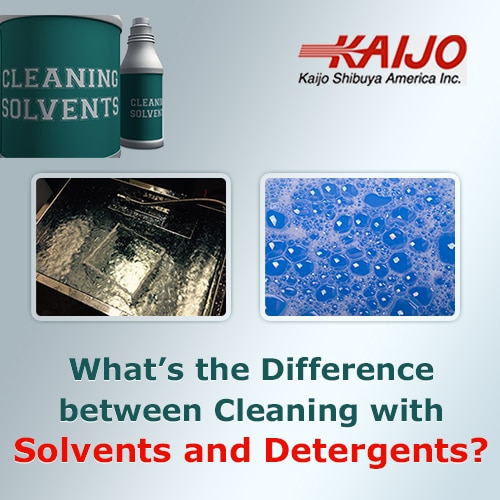What’s the Difference Between Cleaning with Solvents and Detergents?
July 21, 2021
 When industrial parts have to be cleaned, the use of ultrasonic cleaners with detergents offers several advantages over the more traditional cleaning methods of using solvent baths. Used by themselves, detergents have a reputation for not being strong enough to remove tough contaminants, whereas powerful solvents that are matched to the material to be removed can dissolve even heavy contamination. However, it may be surprising to learn that ultrasonic cleaners with detergents in the cleaning solution can actually outperform solvents and work well with all kinds of industrial parts. Switching from solvent-based cleaning to ultrasonic cleaning with detergents can result in cleaner parts and reduced costs.
When industrial parts have to be cleaned, the use of ultrasonic cleaners with detergents offers several advantages over the more traditional cleaning methods of using solvent baths. Used by themselves, detergents have a reputation for not being strong enough to remove tough contaminants, whereas powerful solvents that are matched to the material to be removed can dissolve even heavy contamination. However, it may be surprising to learn that ultrasonic cleaners with detergents in the cleaning solution can actually outperform solvents and work well with all kinds of industrial parts. Switching from solvent-based cleaning to ultrasonic cleaning with detergents can result in cleaner parts and reduced costs.
Detergents and Solvents Clean in Different Ways
While water can dissolve many substances, compounds such as grease and oil resist cleaning with plain water. Detergents form a bridge between the water molecules and oily particles by surrounding the contaminating particles, allowing them to be rinsed away.
Solvents clean by dissolving contaminants. Some solvents can dissolve specific substances while others dissolve a whole range of different compounds. To clean parts effectively, the right solvent must be used to remove the contaminating material from the part surface and put it into a solution. The solution containing the contaminant is then disposed of.
Cleaning with Solvents. vs. Ultrasonic Cleaning with Detergents
Solvents are typically aggressive chemicals such as acetone, naphtha, or turpentine. They are usually flammable and give off noxious fumes. when used for large parts in soaking baths, they can be expensive, and they often have to be treated before disposal because they damage the environment. In some cases, the cost of disposal exceeds the cost of the solvents themselves.
Detergents, by contrast, are inexpensive and safe chemicals that are often biodegradable. Unlike solvents, they are non-flammable, not toxic, and don’t generate fumes. When used with ultrasonic cleaners, they can clean quickly and effectively, without leaving a residue or damaging the parts being cleaned.
Ultrasonic cleaners generate microscopic cavitation bubbles in the cleaning solution. These bubbles produce a scrubbing action that dislodges contaminating material from the surfaces of parts to be cleaned. When combined with detergents, this cleaning action is multiplied, resulting in faster cleaning performance and cleaner parts.
Benefits of Using Detergents with Ultrasonic Cleaners
Switching to ultrasonic cleaning with detergents can improve manufacturing facility performance and reduce costs. Specific benefits include the following:
- A cleaner, more employee-friendly workplace. The absence of noxious fumes and freedom from exposure to harmful chemicals help improve worker morale.
- A safer workplace. Ultrasonic cleaning is completely safe and the detergents used are not harmful. Solvents often have to be handled with protective equipment and spills can be dangerous.
- No need for special fire protection. Solvents are often flammable and require special fire extinguishing measures.
- Reduced cleaning costs. Detergents are less expensive than solvents and ultrasonic cleaning takes less worker time to operate.
- Reduced environmental footprint. Ultrasonic cleaning produces no byproducts and detergents can be biodegradable. Solvents, on the other hand, can’t be discharged into the environment without treatment, and even after being treated, they may still be harmful.
- Improved manufacturing output. Ultrasonic cleaners with detergents clean parts completely, even inside threaded holes or dead-end spaces. Being able to produce cleaner parts can improve output quality and reduce rejects.
Let Kaijo Help You Select the Right Ultrasonic Cleaner and Detergent for Your Application
With our extensive experience in ultrasonic technology and our in-house expertise in designing and building ultrasonic cleaners, Kaijo can help you choose the right system for your cleaning needs. Kaijo works with manufacturers across many industries to make sure their ultrasonic cleaners deliver the highest cleaning performance. Detergents play an important role in ultrasonic cleaning, especially for more challenging applications such as automotive ultrasonic cleaning. Once the cleaning requirements are clear, Kaijo can deliver custom ultrasonic cleaners from its complete range of cleaning systems and components to meet your requirements.





